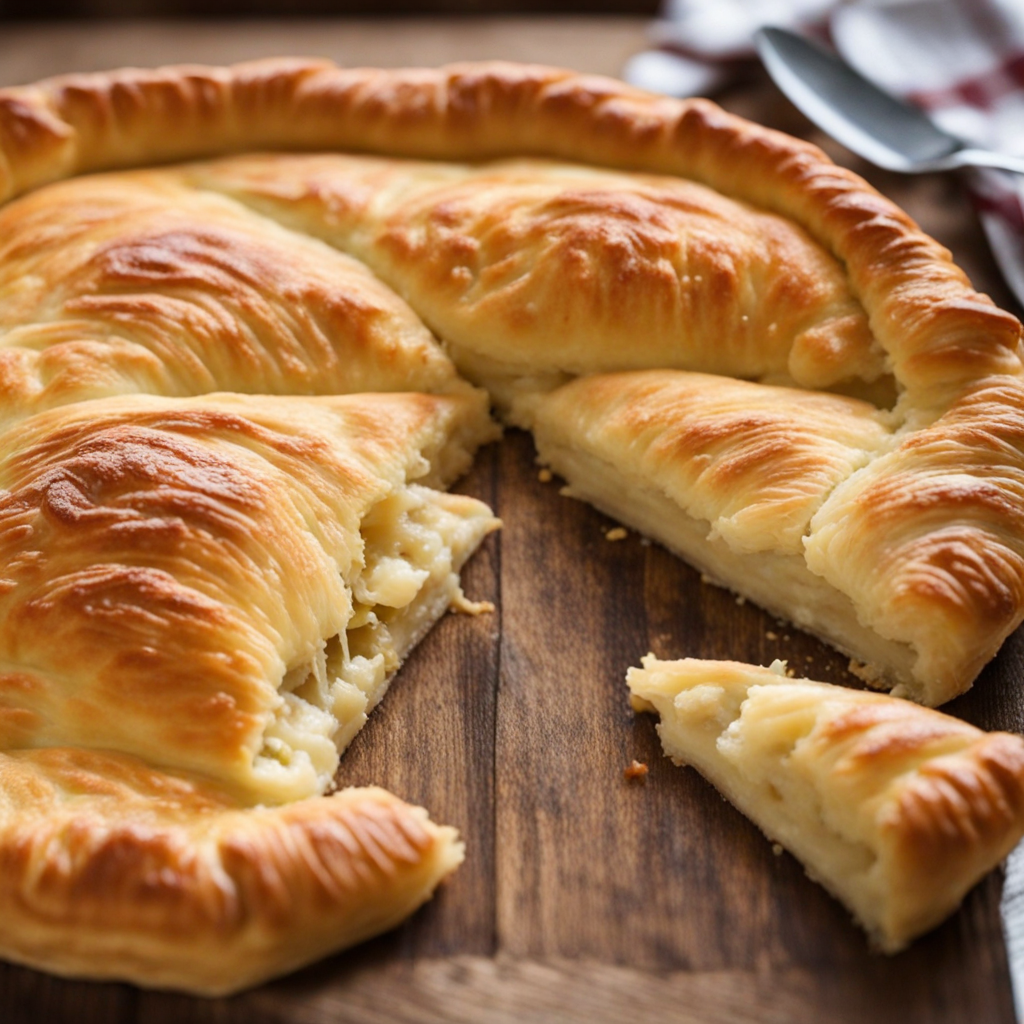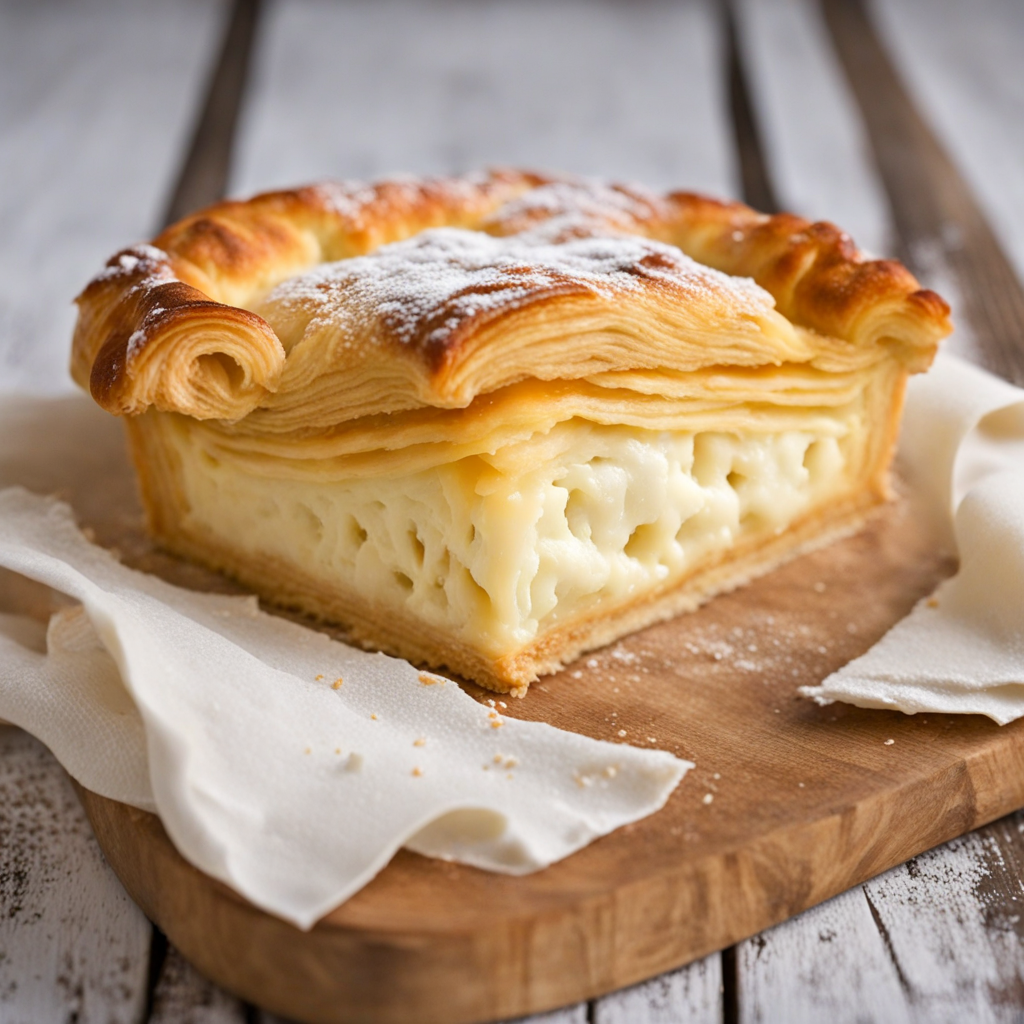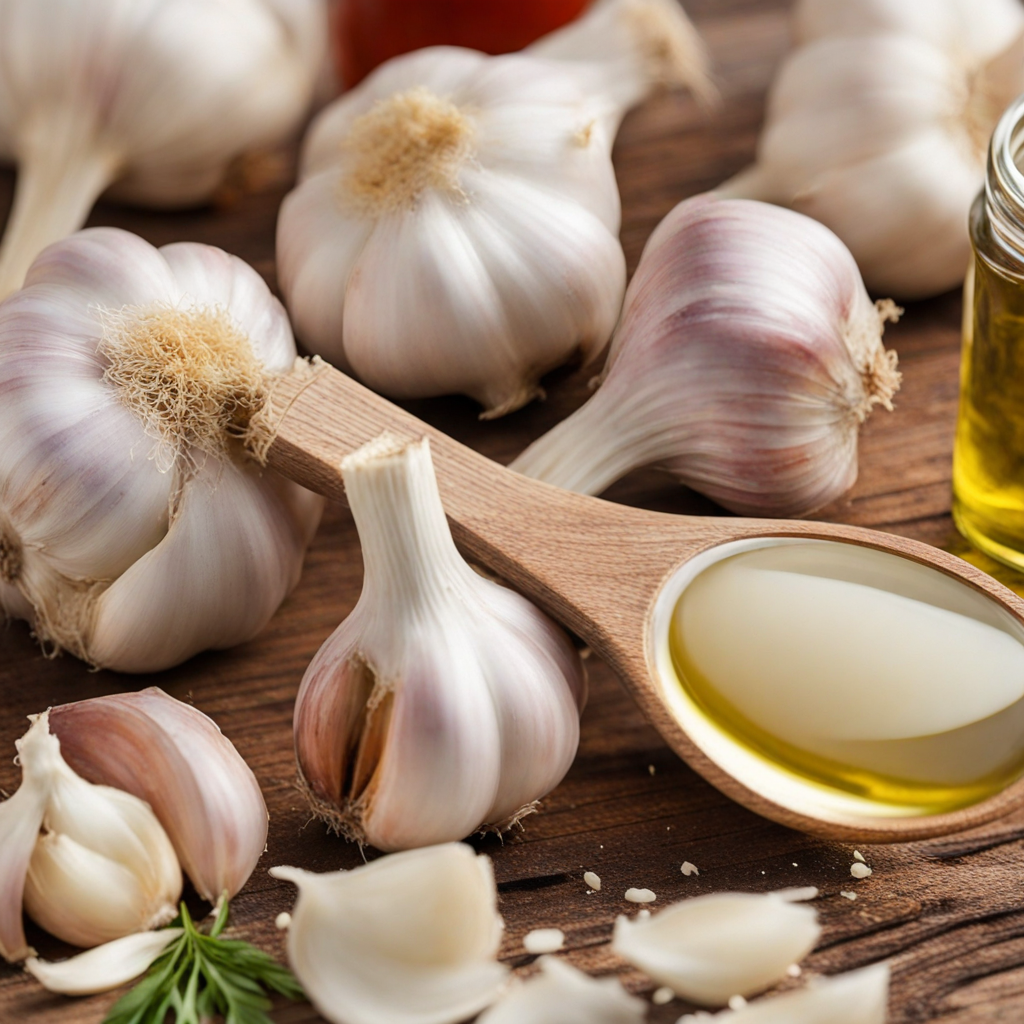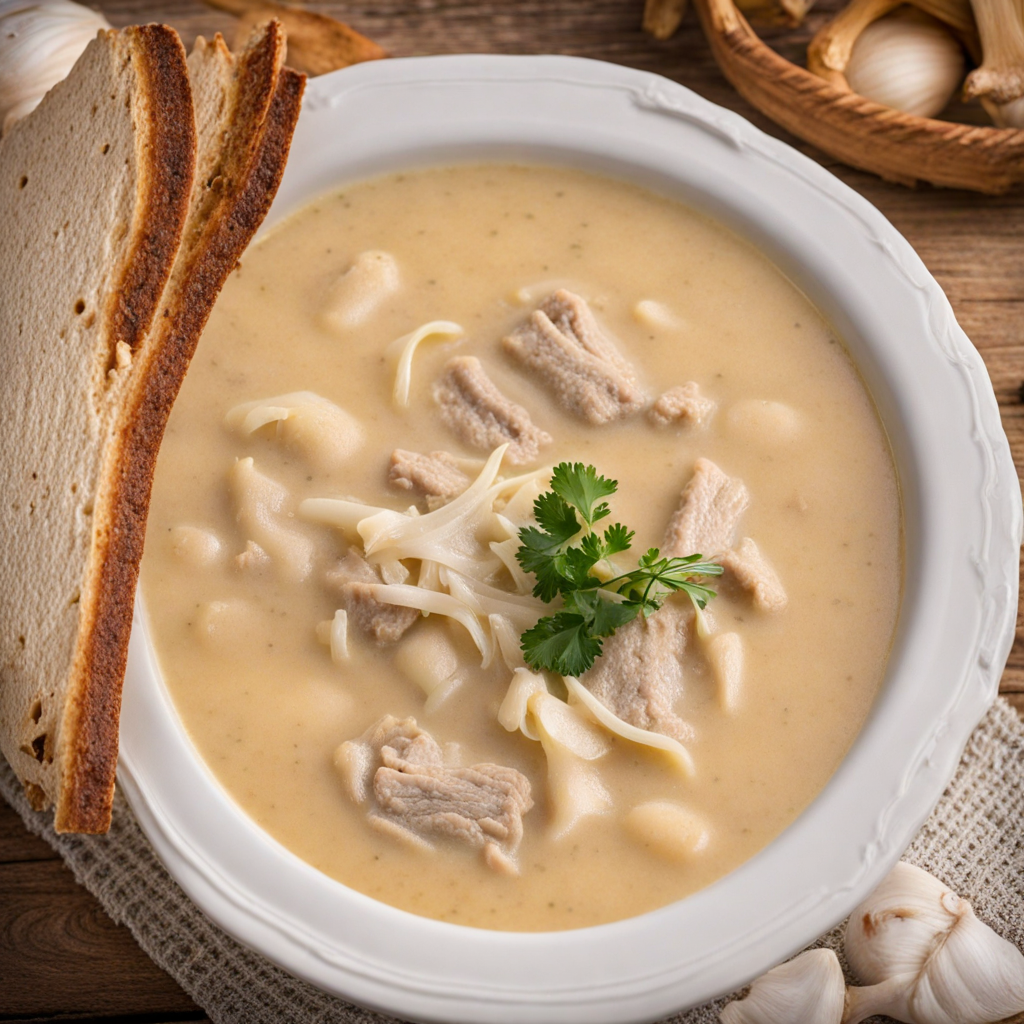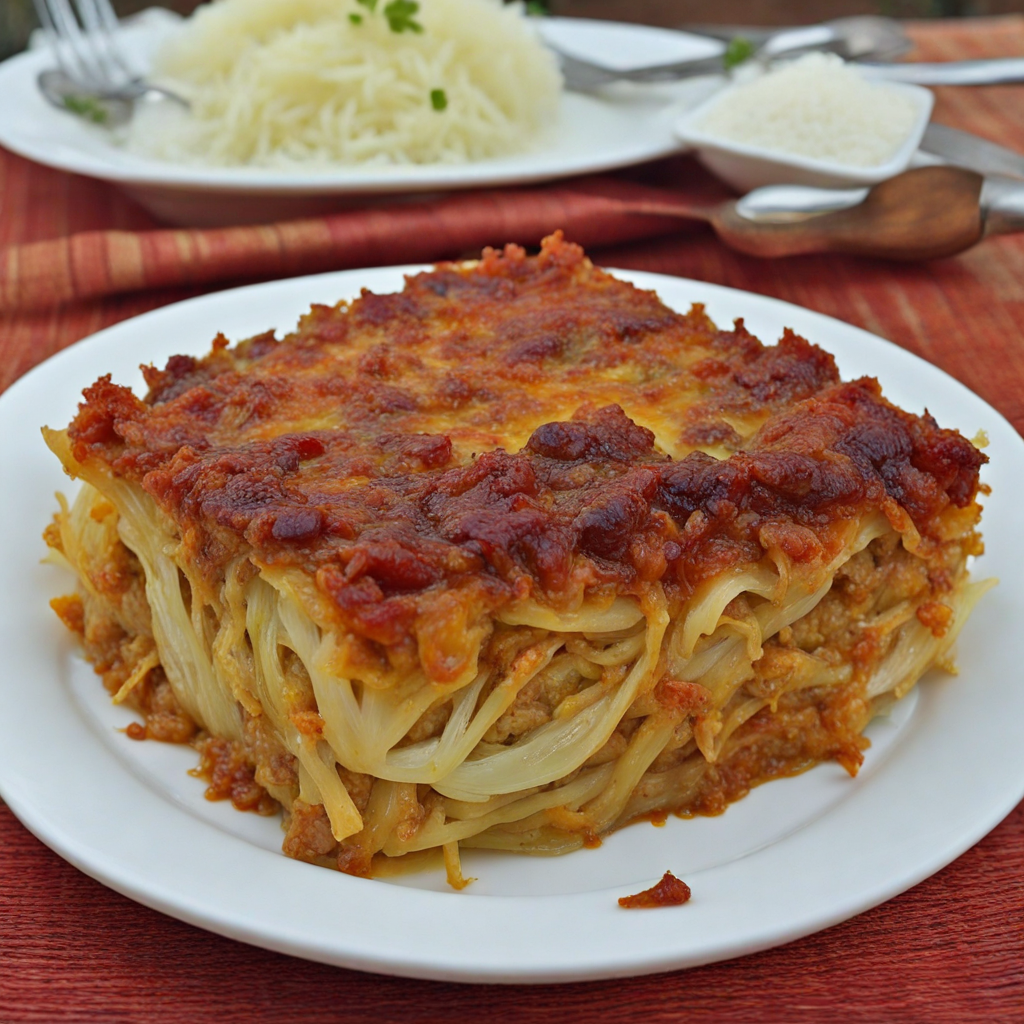Romanian Cheese Pie
Romanian Cheese Pie, known as "Placinta cu Branza," is a delightful pastry that showcases the rich culinary traditions of Romania. This dish features a flaky, golden-brown crust that is both tender and crispy, providing the perfect vessel for its delicious filling. The dough is typically made from simple ingredients like flour, water, and a touch of oil or butter, resulting in a base that is light yet sturdy enough to hold the generous amount of cheese filling within. At the heart of this pie lies a creamy mixture of fresh cheese, often a blend of feta and cottage cheese, mixed with eggs and a hint of sour cream. This combination creates a luscious, savory filling that is both rich and satisfying. Some variations might include herbs such as dill or chives, adding a fragrant note that enhances the overall flavor profile. The cheese filling is encased in layers of the dough, which are sometimes rolled or folded to create a beautiful, spiraled effect that is as pleasing to the eye as it is to the palate. When baked, Romanian Cheese Pie develops a beautiful golden crust with a soft, cheesy interior that melts in your mouth. It's often enjoyed warm and can be served as a comforting snack, an appetizer, or even a light meal. The contrast of the crispy exterior and the creamy, savory filling makes each bite a perfect balance of textures and flavors. Whether enjoyed at a festive gathering or as a simple homemade treat, this pie is a beloved staple in Romanian cuisine that invites you to explore the rich heritage and tastes of the region.
How It Became This Dish
The History of Plăcintă cu Brânză: A Romanian Culinary Treasure Introduction Plăcintă cu brânză, a beloved Romanian pastry, epitomizes the rich culinary heritage of Romania, showcasing the intersection of tradition, agriculture, and communal identity. This cheese pie, typically filled with a mixture of fresh cheese, eggs, and sometimes herbs, carries with it a narrative woven through centuries of Romanian history. From its humble origins to its place on modern dining tables, the evolution of plăcintă cu brânză reflects broader socio-cultural shifts and the enduring spirit of Romanian hospitality. Origins: The Foundation of Romanian Culinary Heritage The roots of plăcintă cu brânză can be traced back to the ancient practices of bread-making and cheese production in the region that is now Romania. The area has been inhabited since prehistoric times, with evidence suggesting that the Dacians, the ancestors of modern Romanians, cultivated grains and domesticated animals for dairy. The word “plăcintă” itself is derived from the Latin “placenta,” indicating a linkage to ancient baking traditions. The earliest forms of plăcintă likely emerged as simple flatbreads filled with local ingredients. As agriculture developed, so did the range of fillings. The introduction of sheep and cow herding in the Carpathian region led to the production of various cheeses, including telemea, a brined cheese akin to feta, which became a staple in Romanian households. The combination of dough and cheese was not only practical but also transcended class boundaries, becoming a dish enjoyed by both peasants and nobility. Cultural Significance: More Than Just a Dish Plăcintă cu brânză is not merely a culinary delight; it carries deep cultural significance in Romanian society. Traditionally served during feasts, celebrations, and family gatherings, it embodies the spirit of community and hospitality. It has become a staple at weddings, holidays, and religious celebrations, symbolizing abundance and the joy of sharing. The dish has regional variations, each reflecting local customs and ingredients. In Transylvania, for example, plăcintă cu brânză may include sour cream or additional herbs like dill, while in Moldavia, it might be sweeter, incorporating raisins or sugar. This regional diversity highlights the adaptability of Romanian cuisine and the importance of local ingredients, reinforcing the sense of identity tied to place. Development Through Time: A Culinary Evolution As Romania underwent various geopolitical changes, especially during the 19th and 20th centuries, so too did plăcintă cu brânză. The Austro-Hungarian Empire's influence introduced new culinary techniques and ingredients, leading to the integration of different styles of pastry-making. The introduction of puff pastry, for instance, allowed for a lighter, flakier version of the traditional pie, which many modern cooks now favor. In the 20th century, the rise of communism in Romania brought about significant changes in food production and consumption. The state’s control over agriculture and food distribution meant that traditional recipes often had to adapt to the realities of scarcity and rationing. While plăcintă cu brânză remained a staple, the fillings sometimes became more basic, with cottage cheese or even processed cheese being used as substitutes. Post-1989, after the fall of communism, Romania experienced a culinary renaissance. Chefs and home cooks alike began to explore their roots, reviving traditional recipes and experimenting with new techniques. Plăcintă cu brânză found its way back to the forefront of Romanian cuisine, celebrated not just for its taste but also for its cultural heritage. Contemporary interpretations have emerged, with chefs adding gourmet twists while still honoring the essence of the original dish. Modern-Day Plăcintă cu Brânză: From Home Kitchen to Gourmet Restaurants Today, plăcintă cu brânză is enjoyed by many, transcending socio-economic barriers. It can be found in homes, street food stalls, and high-end restaurants alike. The resurgence of interest in traditional foods has led to a renewed appreciation for homemade versions, with many Romanians taking pride in their family recipes. In recent years, the dish has also gained international attention, often featured in Romanian restaurants abroad. Food festivals and cultural events celebrate plăcintă cu brânză as a symbol of Romanian identity, inviting people from all backgrounds to experience its flavors and the stories behind them. The Future of Plăcintă cu Brânză As globalization impacts culinary practices, plăcintă cu brânză continues to evolve. The rise of health consciousness has led to variations utilizing whole grains, alternative cheeses, and even plant-based fillings. This adaptability speaks to the essence of Romanian cuisine: it is rooted in tradition yet open to innovation. Moreover, the importance of food sustainability and local sourcing has prompted a resurgence in traditional farming practices. Many contemporary chefs emphasize the use of local, organic ingredients, which not only enhances the flavor of plăcintă cu brânză but also supports local economies and preserves agricultural biodiversity. Conclusion Plăcintă cu brânză is more than just a delicious cheese pie; it is a culinary artifact that encapsulates Romanian history, culture, and identity. From its ancient origins to its modern interpretations, this dish has withstood the test of time, reflecting the resilience and creativity of the Romanian people. As it continues to evolve, plăcintă cu brânză serves as a delicious reminder of the importance of food in connecting us to our heritage, our communities, and each other. Whether served at a festive gathering or enjoyed as a simple snack, plăcintă cu brânză remains a cherished symbol of Romanian hospitality and pride.
You may like
Discover local flavors from Romania


